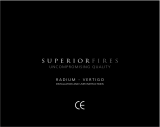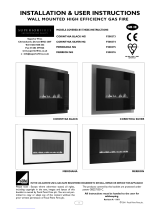CHECKING THE BURNER
There are no imitation fuel bed components to install. The appliance features a ribbon burner which is
designed to produce a continuous band of flame over it’s length. The burner should be visually
inspected to ensure it is free from any foreign matter. If it is necessary to clean or dust off the burner
then the glass door should be removed by removal of the retaining screws. Re-fit the glass door after
cleaning or inspection, ensuring a good seal.
TESTING AND COMMISSIONING
Turn on and test the gas supply up to the fire for any leaks, in accordance with the current edition of
BS6891.
OPERATING THE APPLIANCE
The pilot is visible behind the left hand side of the burner.
The control knob is located on the lower right hand side of the
outer case. It is of a spherical design and is marked as shown
in the diagram to the right;
Push in and turn the control knob to the SPARK position, and
hold there for a few seconds.
Continue turning anti-clockwise through the spark click to the
PILOT light position, ensuring the pilot has lit. If not, return the
knob clockwise, and repeat.
When the pilot lights after the spark, keep the knob depressed
for approximately ten seconds. Now release the knob and the
pilot should stay alight. If the pilot is extinguished during use,
wait three minutes before repeating the ignition procedure. To
achieve the HIGH setting, push the control knob in slightly and
continue turning anti-clockwise to the high position. The main
burner should light after a few seconds. To decrease the setting
to LOW, turn the control knob clockwise to the low setting.
To turn to the PILOT position from the HIGH or LOW positions, press the control knob in, and return to
the pilot position and release. To turn the fire OFF, keep the knob pressed in, return to the off position
and release.
SPARK FAILURE
The gap between the spark electrode and the pilot should be 3 - 5mm to produce a good spark. There
should be no need to adjust this. If under any circumstances the piezo electric spark fails, the pilot
cannot be lit manually.
SETTING PRESSURE
The pressure test point is located on the left hand side of the appliance, on the main burner pipe, next
to the brass restrictor/connector. Release the setting pressure test point screw, and attach a U gauge.
Light the fire on the HIGH setting.
To commission the appliance, the burner pressure must be in accordance with the figures stated in the
data section of these instructions. The fire is factory set to achieve these pressures and any significant
variation could indicate a supply problem. If the pressure is too high, the gas supply meter may be set
incorrectly. This should be checked with the fire running and if necessary reset by the gas supplier.
If the burner pressure is too low, then check the inlet pressure with the appliance running. If this is
less than approximately 20mbar it will need to
be reset by the gas supplier. If the setting pres-
sure is too low, but the meter pressure is accept-
able, then a problem in the supply pipework is to
be suspected.
This will be dirt and debris, kinked or inadequate
size pipes, restriction in a fitting, shut off elbow
not fully open or solder flashing across a joint.
Identify the cause of the restriction and rectify.
Switch the fire off, disconnect the U gauge and
refit the test nipple screw. Light the fire and
check for gas soundness.
In the event that the burner pressure is not in
accordance with the figures stated in the data
section of these instructions, the appliance must
not be commissioned, and the manufacturer
should be contacted for guidance.
6
‘OFF’ position
‘SPARK’ position
‘LOW’ position
‘HIGH’ position
7.2
8.0
8.1
8.3
8.2



















